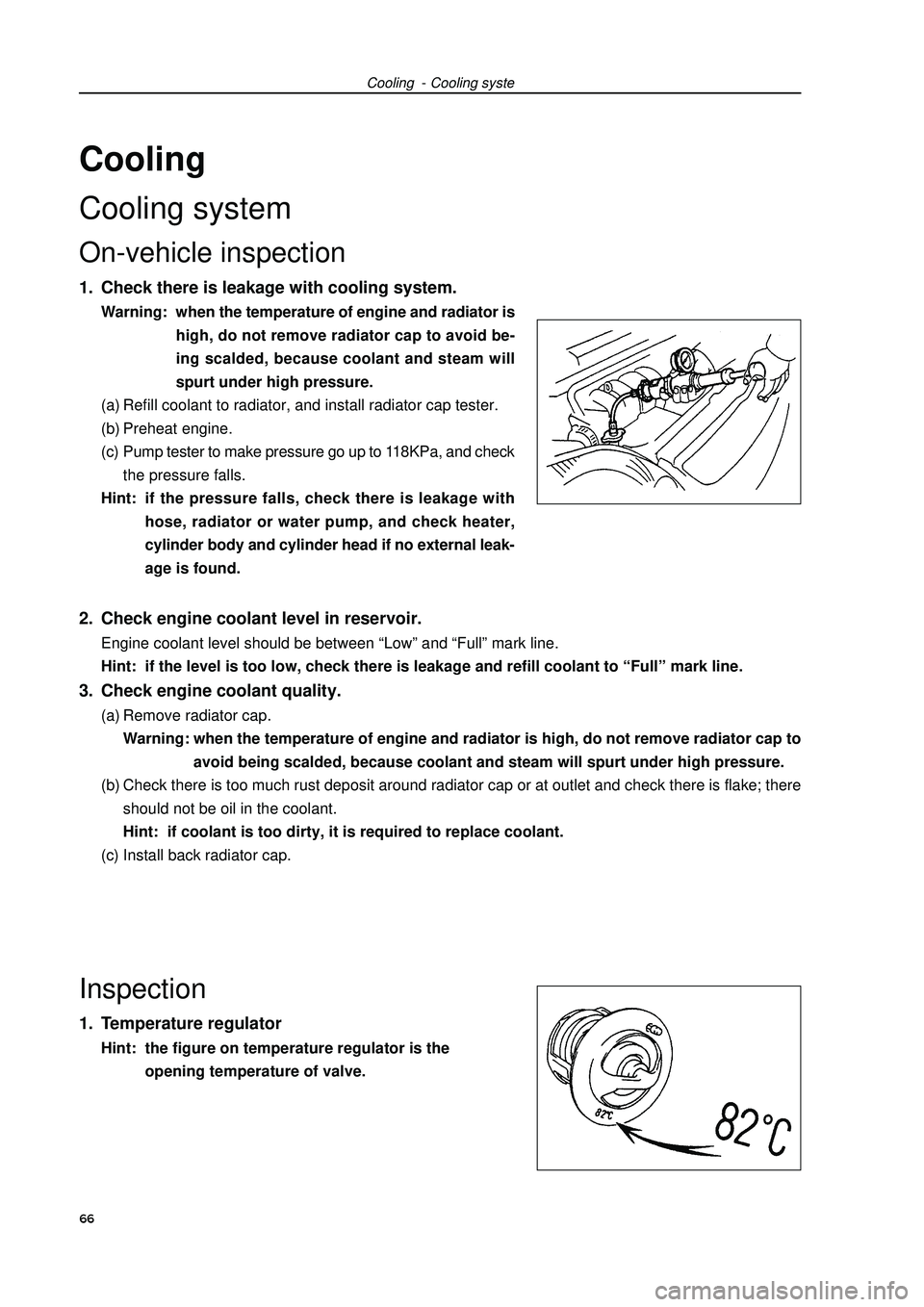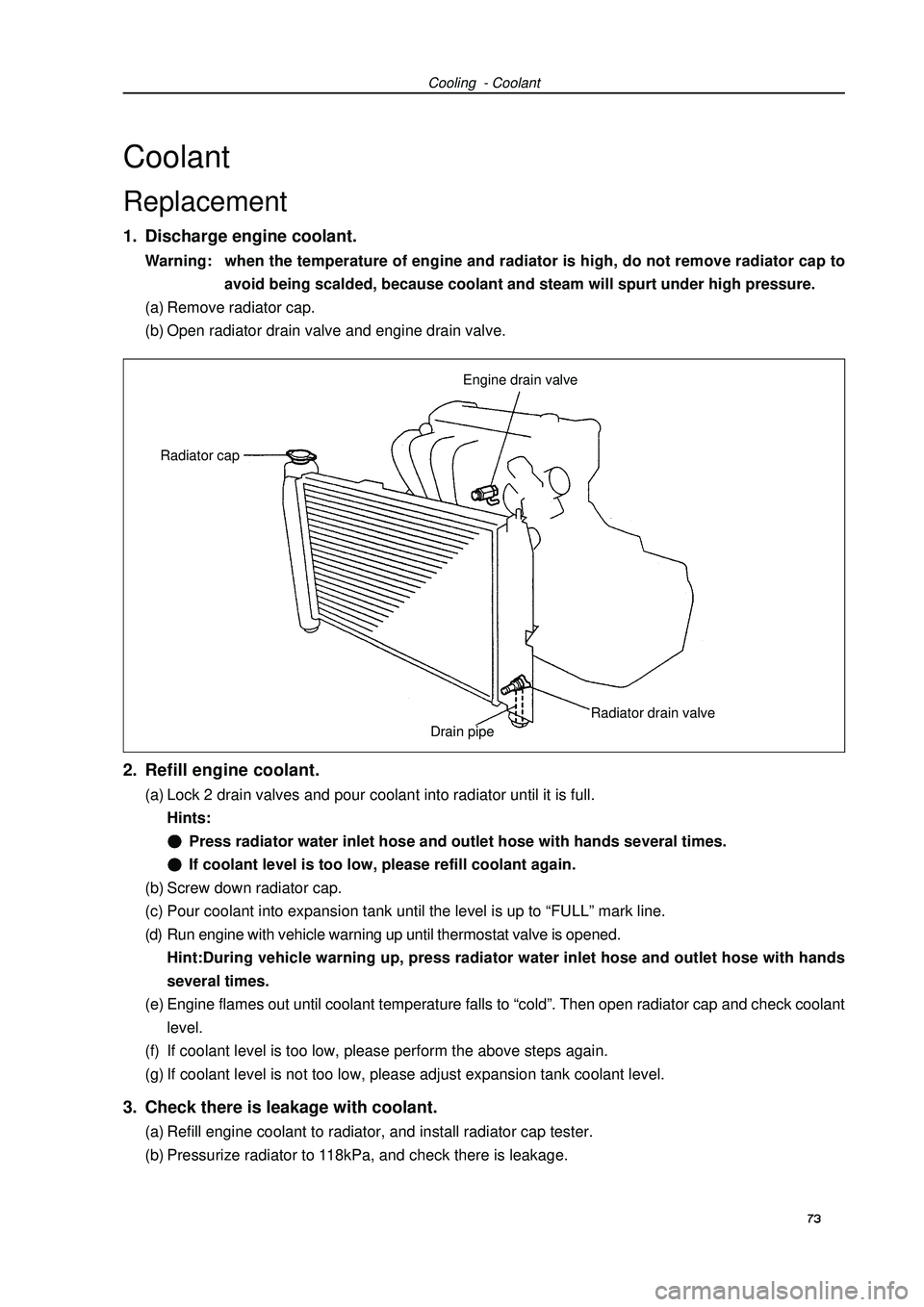check engine GEELY FC 2008 Owner's Guide
[x] Cancel search | Manufacturer: GEELY, Model Year: 2008, Model line: FC, Model: GEELY FC 2008Pages: 419, PDF Size: 13.87 MB
Page 73 of 419

Engine mechanism - Crankshaft rear oil seal assemblyReplacement1. Remove transmission assembly.
2. Remove clutch assembly and flywheel components.Fix crankshaft with special tool, remove clutch assembly at
first, and then remove flywheel components.3. Remove crankshaft rear oil seal.(a) Cut oil seal mouth with blade.
(b) Prize out oil seal with flathead screwdriver whose sharp
end is winded with tape.
Note: check crankshaft is damaged after removing oil
seal, and repair with abrasive paper (#400) if it is
damaged.4. Install crankshaft rear oil seal [4G18-1002130].(a) Coat a little MP grease on new oil seal lip.
Note: do not let oil seal lip contact with foreign
matters.
(b) Gently knock new oil seal in with special tool and hammer
until the seal surface is parallel and level with the end sur-
face edge of mounting hole.
Note: wipe off redundant grease on crankshaft.5. Install flywheel components and clutch assembly.(a) Fix crankshaft with special tool.
(b) Clean bolts and bolt holes.
(c) Coat bolts with adhesive.
Adhesive: thread locking adhesive 1234 (Kesaixin 1234)
(d) Install flywheel components.
As sequences shown in the diagram, tighten bolts at sev-
eral times.
Torque: (e) Install clutch assembly.6. Install transmission assembly.Special
tool
Cut
positionSpecial
tool62Crankshaft rear oil seal assembly
Page 75 of 419

Engine mechanism - Cylinder cover gasket components(c) Tighten each cylinder head bolt in turn again.
Torque: m
(d) Install heating air water outlet pipe components.
Torque: 8. Install camshaft.(a) Coat engine oil on camshaft journal.
(b) Put 2 camshafts on cylinder head and with cylinder 1 cam-
shaft end toward the direction shown in the diagram.
(c) Check forward remarks and figures of all bearing cover, and
tighten the bolts as sequences shown in the diagram.
Torque:
Camshaft front bearing cover: Camshaft bearing cover: 9. Check idle speed and ignition timing.
10. Check compression pressure.
11. Check CO/HC.64
Page 77 of 419

Cooling - Cooling syste2. Check engine coolant level in reservoir.Engine coolant level should be between “Low” and “Full” mark line.
Hint: if the level is too low, check there is leakage and refill coolant to “Full” mark line.3. Check engine coolant quality.(a) Remove radiator cap.
Warning: when the temperature of engine and radiator is high, do not remove radiator cap to
avoid being scalded, because coolant and steam will spurt under high pressure.
(b) Check there is too much rust deposit around radiator cap or at outlet and check there is flake; there
should not be oil in the coolant.
Hint: if coolant is too dirty, it is required to replace coolant.
(c) Install back radiator cap.Inspection1. Temperature regulatorHint: the figure on temperature regulator is the
opening temperature of valve.CoolingCooling systemOn-vehicle inspection1. Check there is leakage with cooling system.Warning: when the temperature of engine and radiator is
high, do not remove radiator cap to avoid be-
ing scalded, because coolant and steam will
spurt under high pressure.
(a) Refill coolant to radiator, and install radiator cap tester.
(b) Preheat engine.
(c) Pump tester to make pressure go up to 118KPa, and check
the pressure falls.
Hint: if the pressure falls, check there is leakage with
hose, radiator or water pump, and check heater,
cylinder body and cylinder head if no external leak-
age is found.66
Page 79 of 419

Cooling - Cooling fan systemCooling fan systemOn-vehicle inspection1. Check cooling fan function at low temperature (below 95).(a) Turn ignition switch to ON.
(b) Check cooling fan is stopped.
Hint: if it is not stopped, check cooling fan relay and water temperature sensor, or check the
joint or wire harness between them.
(c) Uncouple water temperature sensor joint.
(d) Check cooling fan runs.
If it does not run, check fuse, cooling fan relay, engine ECU and cooling fan, or check there is short
circuit between them.
(e) Connect back water temperature sensor joint.2. Check cooling fan function at high temperature (above 95).(a) Start engine and increase coolant temperature up to above Hint: water temperature is the value measured by water temperature sensor on water outlet.
(d) Check cooling fan runs.
Hint: if it does not run, please replace water temperature sensor.3. Check cooling fan.(a) Uncouple cooling fan joint.
(b) Connect battery and ampere meter to cooling fan joint.
(c) Check cooling fan runs normally and check ampere meter reading.Standard current: 712A
(d) Connect back cooling fan joint.Inspection1. Electronic fan relay [67000064]
2. Electronic fan relay II [67000072]
3. Cooling fan speed adjusting resistance assembly
[67000001]Measure resistance between terminals with ohmmeter.
Resistance: at normal temperature: 1.368 Specified
conditions
Normal stateConductionConductionTerminal connected
by three-use meter Conditions
Supply battery voltage
to No. 1 and No. 2
terminals
Specified
conditions
Normal stateConductionConductionTerminal connected
by three-use meter Conditions
Supply battery voltage
to No. 1 and No. 2
terminals
Page 81 of 419

Cooling - Water pump assembly6. Install water pump assembly.(a) Install new o-ring on water pump.
(b) Install water pump with 6 bolts.
Torque: bolt A: Bolt B: 7. Install alternator mounting components.Torque: 12mm bolt head: 14mm bolt head: 8. Refill engine coolant.
9. Check there is leakage with coolant.
70
Page 82 of 419

Cooling - Temperature regulator componentsReplacement1. Remove engine right bottom shield.
2. Discharge engine coolant.
3. Remove drive belt.Slowly turn drive belt tensioner clockwise to loosen the belt;
then remove drive belt and put back the tensioner slowly to
completely loosen it.4. Remove alternator components.(a) Remove rubber cover and nuts.
(b) Uncouple alternator joint.
(c) Remove 2 bolts and alternator.5. Remove water inlet pipe.
6. Remove temperature regulator.
7. Install temperature regulator.(a) Install new gasket to temperature regulator.
(b) As shown in the diagram, install temperature regulator with
inching valve toward upward.8. Install water inlet pipe and joint.Torque: 9. Install alternator installation components.Torque: 12mm bolt head: m
14mm bolt head: 10. Refill engine coolant.
11. Check there is leakage with coolant.
71Temperature regulator components
Page 83 of 419
![GEELY FC 2008 Owners Guide Cooling - Radiator with electronic fan assemblyRadiator with electronic fan assemblyReplacement1. Discharge coolant (see Page 73).
2. Disassemble radiator water inlet hose [64000062].
3. Disassemble GEELY FC 2008 Owners Guide Cooling - Radiator with electronic fan assemblyRadiator with electronic fan assemblyReplacement1. Discharge coolant (see Page 73).
2. Disassemble radiator water inlet hose [64000062].
3. Disassemble](/img/58/57161/w960_57161-82.png)
Cooling - Radiator with electronic fan assemblyRadiator with electronic fan assemblyReplacement1. Discharge coolant (see Page 73).
2. Disassemble radiator water inlet hose [64000062].
3. Disassemble radiator water outlet hose [64000063].
4. Disassemble No.1 oil cooler inlet pipe (auto gear).
5. Disassemble No.1 oil cooler outlet pipe (auto gear).
6. Disassemble fixing clips of 2 wire harnesses from fan cover.
7. Remove mounting bracket assembly on radiator [64000058].
8. Remove radiator together with electronic fan assembly [64000057].
9. Remove electronic fan together with fan cover assembly [64000060].(a) Screw off fixed nuts connecting electronic fan together with fan cover assembly with radiator.
(b) Uncouple fan motor joint.
(c) Remove 2 bolts of fan.
(d) Remove fan motor at the same time.10. Replace and install as sequences opposite to the above.
11. Refill engine coolant (see Page 73).
12. Check there is leakage with coolant (see Page 66).
72
Page 84 of 419

CoolantReplacement1. Discharge engine coolant.Warning: when the temperature of engine and radiator is high, do not remove radiator cap to
avoid being scalded, because coolant and steam will spurt under high pressure.
(a) Remove radiator cap.
(b) Open radiator drain valve and engine drain valve.Cooling - Coolant2. Refill engine coolant.(a) Lock 2 drain valves and pour coolant into radiator until it is full.
Hints:Press radiator water inlet hose and outlet hose with hands several times.If coolant level is too low, please refill coolant again.
(b) Screw down radiator cap.
(c) Pour coolant into expansion tank until the level is up to “FULL” mark line.
(d) Run engine with vehicle warning up until thermostat valve is opened.
Hint:During vehicle warning up, press radiator water inlet hose and outlet hose with hands
several times.
(e) Engine flames out until coolant temperature falls to “cold”. Then open radiator cap and check coolant
level.
(f) If coolant level is too low, please perform the above steps again.
(g) If coolant level is not too low, please adjust expansion tank coolant level.3. Check there is leakage with coolant.(a) Refill engine coolant to radiator, and install radiator cap tester.
(b) Pressurize radiator to 118kPa, and check there is leakage.73Engine drain valve
Radiator drain valve Radiator cap
Drain pipe
Page 85 of 419

LubricationLubricating systemOn-vehicle inspection1. Check oil level.During engine warming up and after it flames out for 5 minutes, check oil level, and the level should
be between two marks on oil dipstick at the moment.If oil level is too low, check there is leakage, and
refill oil up to upper mark on oil dipstick.
Note: oil level should not be above upper mark on oil
dipstick.2. Check oil quality.(a) Check there is deterioration, water penetration, color
change or thinning with oil.
(b) If oil quality becomes poor, please replace with new oil.
Hint: oil grades: API, SH, SJ, SG grade oil or ILSAC
multigrade oil. Recommended viscosity is
shown as below.
The temperature increases from left to right.3. Remove oil pressure alerter assembly.(a) Uncouple oil pressure alerter joint.
(b) Install oil pressure alerter with special tool.4. Install oil pressure gauge.Install oil pressure gauge.5. Warm up vehicle.
6. Check oil pressure.Oil pressure:7. Install oil pressure alerter.(a) Coat adhesive on 2nd or 3rd circle thread of oil pressure
alerter.
Adhesive: anaerobic pipe thread sealing adhesive
1545 (Kesaixin 1545).
(b) Install oil pressure alerter with special tool.
Torque: m
(c) Connect oil pressure alerter joint.8. Start engine and check there is leakage.Lubrication - lubricating systemRecommended viscosity (SAE)
Oil pressure alerter
Oil pressure gauge
Adhesive74Temperature range in forecasting next
oil replacement
Page 86 of 419

Oil filter assemblyReplacementWarning:Long-term or repeat contacting mineral oil will cause decomposing of natural fat on skin, which
will result in dry and sensitive skin and skin rankling. Used oil has potential harm and may cause
carcinoma cutis.When replacing engine oil, always wear protective clothes and gloves to avoid waste oil
penetrating, and reduce the frequency and time of skin contacting waster oil, and clean with
soapy water or clean water not with gasoline, thinner or solvent if skin contacts waste oil.To protect environment, waste oil and oil filter must be abandoned at named place.1. Remove engine right bottom shield.
2. Discharge engine oil.
3. Remove oil filter assembly [4G18-1012100].Remove oil filter with special tool.4. Install oil filter assembly.(a) Check and clean oil filter junction plane.
(b) Coat oil seal of new oil filter with clean oil.
(c) Tighten oil filter with hands to the extent that oil seal
just touches fixing base.
(d) Tighten oil filter for another 3/4 circle with special tool.5. Install oil drain plug [4G18-1009101].Clean oil drain plug, and install it back after replacing oil drain plug gasket.
Torque: 6. Refill engine oil.
7. Check there is oil leakage.Lubrication - Oil filter assemblySpecial tool75Special tool 3/4 circle